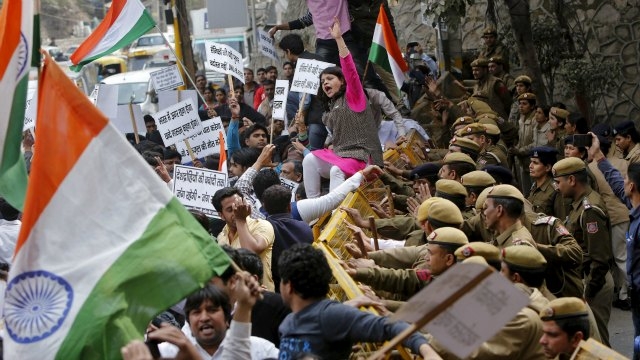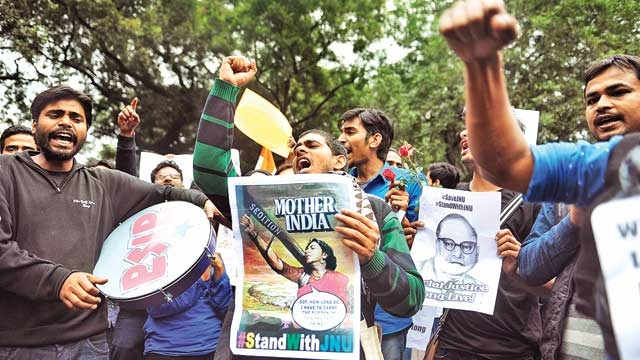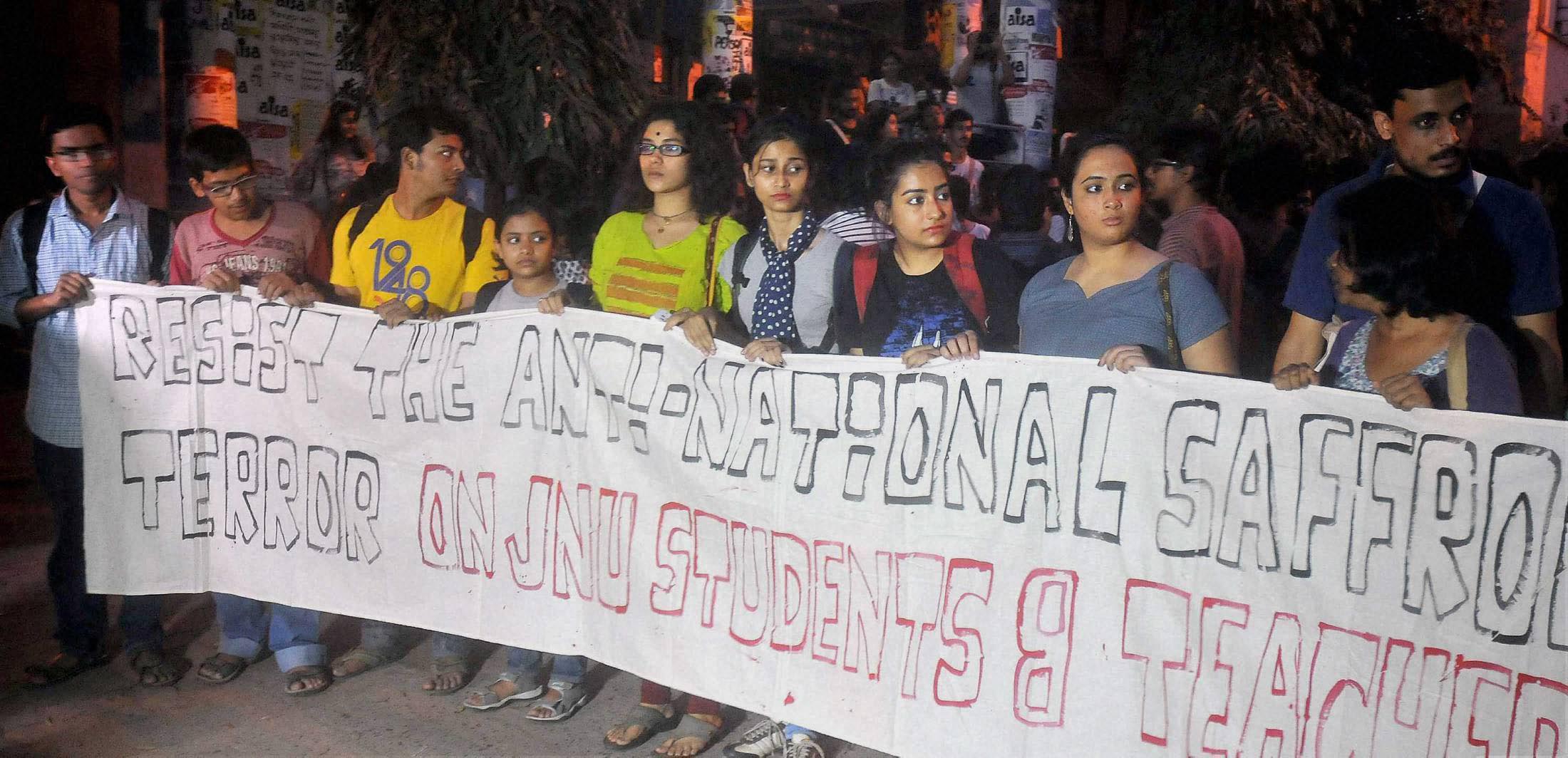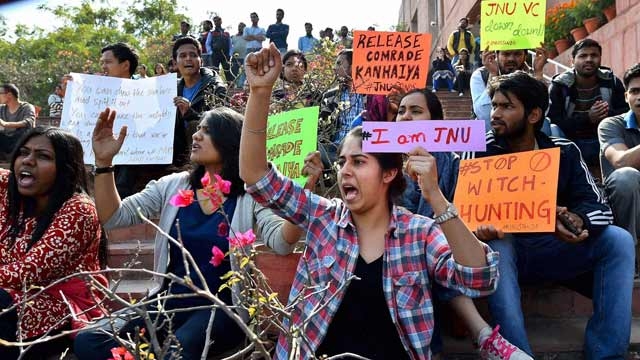
If you are a patriot, then in the last few days, you would have shed a tear, vented on your social media account and sighed deeply at seeing India’s potential, its future and strength—its youth—being drawn into street politics and being played as pawns in the great Indian political game. The events following the sloganeering at the Jawaharlal Nehru University on February 9 have captured the mood of the nation— anger and frustration.
If you are a patriot you would have wondered how farmer deaths, Make in India week or even the Indian women's cricket team's win saw no reaction from the people. The newspapers, TV channels and social media are fully engaged in what the politicians “wish for”— others fighting their battles for them. But this time around, it's not the jobless angry youth in a remote state or a bunch of farmers in far off rural areas angry at their plight or religious fundamentalists fighting for their beliefs or people from a specific community demanding their rights. This time around, those drawn into the battle are India’s students in universities across the country.
This is a frightening proposition. These are our brightest minds, angry at the access the state and politicians are seeking to their free space— their campus. The line-up of students outside the Jadavpur University in West Bengal creating a human chain to bar the entry of Bharatiya Janata Party workers into their campus is deeply disturbing. In other places, it’s the student bodies of different political parties fighting each other inside and outside the campus.
These young people are our future leaders in science, business, administration, entertainment, medicine, law and even in politics, to say the least. They are on the streets fighting each other for a cause. If you were a patriot, you would be worried and sad today. You would ponder over the nation’s future path.

Reuters
India is a nation with the largest youth population with 65% Indians below the age of 35 years. There are 430 million Indians between the age of 15 and 34 and, by 2021, 465 million Indians will fall within this age group. India adds 13 million young people to the job market every year, over a million a month. The figures are staggering and beat the population numbers of many countries. Therefore, our youth needs not only the gentle handholding all young people need everywhere, but our youth also needs the benefit of a strategic thought carved out especially for them.
Prime Minister Narendra Modi, in his many speeches in India and abroad, has celebrated India’s youth as its strength. By engaging with the Youth Congress even the Congress Vice President Rahul Gandhi has shown that he understands the role this important voter base plays in deciding the future course of the nation. But while politicians and political parties have realised the potential and importance of our youth, they have only paid lip service to the cause of their future and their strength. If you are a patriot you would wonder as to why the young have been treated thus by our policymakers. Let us examine how.
The lack of a holistic education that goes beyond education being a “fundamental right” at the school level to being a stepping-stone into the world, is limiting the opportunities our young people can have in the ever-changing world. The quality of public and private education remains disconnected with what is needed to live a full life in the 21st century. The process of memorising has taken over learning. By the time our young get to colleges or universities they are already exhausted with the process of education itself. How is that progress? At the college level, examination and minimum attendance take precedence over critical thinking, avid exploration and open discussion. Most students feel stifled in our colleges and universities.

Image credit: Manit Balmiki/dna
Let's face it. We are not creating enough jobs for our young people. We put them through years of education or vocational training and then we don’t have jobs to offer to them. Many a times, several sectors will have jobs but there will be no young people wanting to join them. Take, for example, the transport sector. Some 40000 odd jobs are vacant as truck drivers but we have sold another dream to our youth and they won’t like being employed as a truck driver. Make in India will not be successful if the young continue to imagine factory work as below their dignity. What have we done to understand the expectations of our young people as far as their livelihood choices are concerned. We want to unleash Make in India or MGNAREGA unto them, to give them an opportunity they actually don’t seek. They don’t want to break stones for 100 rupees a day! Therefore, we need to get creative in career guidance, skill guidance and strategic in investing in sectors in which our young people want to and can get employed. If the employability of our youth continues to mismatch their employment opportunities, we will see rise in income inequalities, frustrations and crime, at a scale unprecedented in the world so far.
For some reason, we feel our young don’t need to know everything. For some reason, we have felt that it is important to chide our youth about what is healthy and what is not. Take the statutory warnings that appear during films or television programmes about smoking. It is sad to think that our lawmakers believe this would help in curb smoking. A young student mentioned to me at a movie theatre that these warnings made him want to step out for a smoke! India is ranked globally among the top three countries for banning websites and social media accounts. So much for Free Speech. We ban something and that gives our young people the curiosity to seek that. When the world lauds their IT skills, why do we think they won’t know the loopholes in accessing these social media accounts or websites? Communication for any nation in today’s times is a strategic tool more than ever before but it is an imperative bridge with the youth. India has yet to contemplate and comprehend this. We have no strategic thought in how we want to communicate and engage with our young people without suffering from the eternal paranoia of the young “knowing too much” or the redundant belief that the young “know nothing.”

Protests by students of Jadavpur University. PTI
If more than half the population of a nation is young, there is bound to be active youth participation in that nation’s politics. It is something we should be proud of. But we have not prepared our young people for this responsibility. For years now, before any major elections, the Election Commission and even political parties remind youth of their democratic franchise as a fundamental right and many young people vote also but without fully comprehending how elections work. We have done nothing to educate them experientially and comprehensively about what our Constitution is about and how they have a role to play in working it as much as the people they elect do. Our civic studies and social studies textbooks are overlooked even in the classrooms by teachers, let alone students and parents. Sadly, we have done nothing to make this an important process to address and fix. Even when the students get to college, they are limited to student union politics without being nurtured for transformation into effective leaders of tomorrow. How can a nation with the largest young voter base in the world continue to be so ill prepared for engaging its youth in politics?

PTI
These are just a few of the major issues we need to think over. But what would deliver more fruitful results is bringing an extra focus on the National Youth Policy, and converting it into a document of strategic thought. This conversion must happen in partnership with our youth, engaging them through effective communication tools and platforms on a range of issues that define and affect their lives. The current policy covers all of the above-examined issues and many additional issues but it lacks a strategic roadmap. The results framework document used by the Ministry is also focused on numbers as goals and not looking at the quality of delivery. But most importantly there is limited constant engagement with the young people, majority of whom don’t even know that there is a national youth policy. Maybe we can even begin with having a ministry of Youth Affairs only for the youth and not mixing it up with sports to give the young the much needed attention and focus. If we are interested and committed to giving our young people the attention they deserve then we can begin anywhere and anytime.
So if you are a patriot and worried about what you are watching unfold for our young people currently, then you need to ask why are we so callous about our largest strategic strength, our demographic dividend, our future. If you are a patriot, you need to question the lawmakers on what strategic roadmap they have for our young people. If you are a patriot you will remind the government of the day that it is the young that will take any nation forward but, in India's case, the young will build the road ahead. If you are a patriot you will not allow our young to be used as political pawns. If you are a patriot you will shed a tear, vent on social media and sigh deeply for the lack of strategic thought India continues to have for its young people.
Bhairavi Jani is Chairperson, IEF & Executive Director SCA Group.